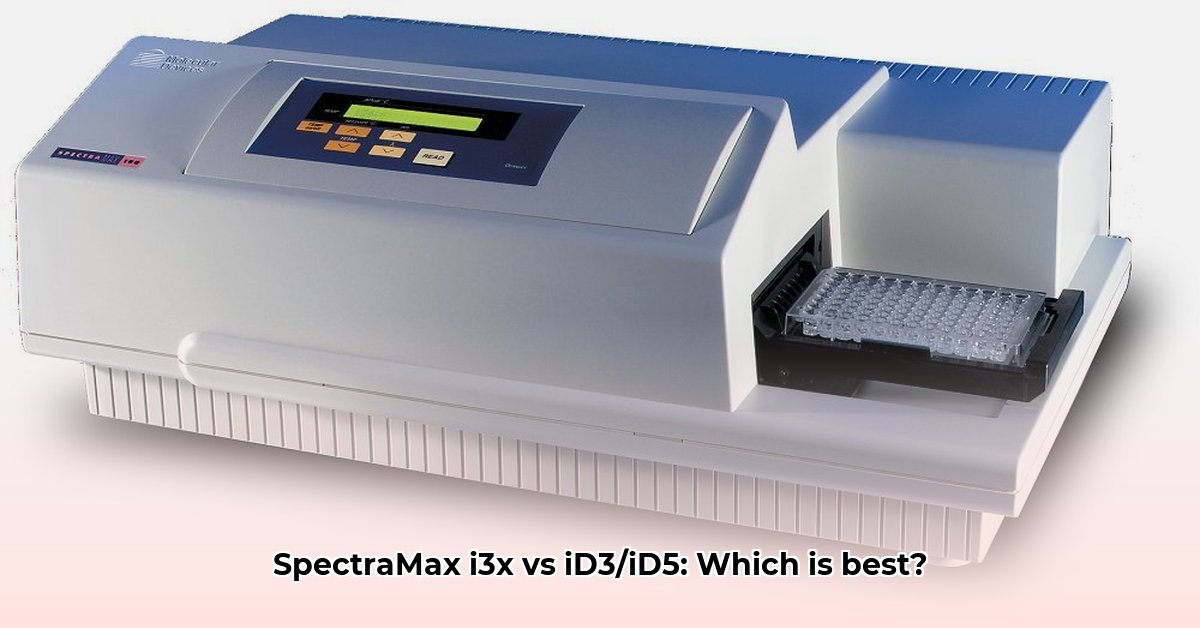
Choosing the right microplate reader is crucial for accurate and efficient research. This comparative review analyzes two leading models from Molecular Devices: the SpectraMax i3x and the iD3/iD5. We'll dissect their features, performance, and suitability for various research settings, assisting you in making an informed decision. This analysis considers factors like versatility, software capabilities, modularity, and regulatory compliance.
Versatility and Assay Capabilities
Both the SpectraMax i3x and the iD3/iD5 excel in performing standard assays such as absorbance, fluorescence, and luminescence measurements. However, the iD5, and the i3x with the appropriate add-ons, expands capabilities to more complex assays including TR-FRET and AlphaScreen. The i3x also offers superior capabilities for Western blot analysis. Both utilize sensitive detectors to minimize background noise. The i3x features Spectral Fusion Illumination, while the iD3/iD5 employs an ultra-cooled PMT for enhanced sensitivity. Which reader is "best" hinges entirely on individual research specifics. Do you need the advanced capabilities of the i3x or will the streamlined iD3/iD5 suffice?
Software and Data Handling: Ease of Use and GxP Compliance
Both readers utilize SoftMax Pro software, although their functionality varies. The modular i3x allows expansion as your needs evolve. This flexibility is advantageous for labs anticipating future expansion of assays. Conversely, the iD3/iD5 offers a streamlined experience via touchscreen controls and NFC technology for rapid protocol access. This user-friendly interface is ideal for high-throughput labs performing repetitive assays. The iD3/iD5 also provides a strong advantage for Good Experimental Practices (GxP) compliance with SoftMax Pro 7.2 GxP and its validation package. Its QuickSync feature facilitates rapid data export to Excel, saving researchers valuable time. What's your priority: expandability or streamlined efficiency?
Modularity versus Efficiency: A Trade-off Between Flexibility and Speed
The i3x's modularity offers exceptional flexibility, allowing customization to meet evolving research demands. This adaptability, however, requires a more complex setup. The iD3/iD5 prioritizes speed and efficiency, making it ideal for high-throughput laboratories prioritizing rapid data output. The choice depends entirely on your research objectives. If adaptability is paramount, the i3x prevails. However, if a rapid, intuitive workflow is key, the iD3/iD5 is the stronger choice.
Key Technological Differences: A Detailed Comparison
Let's examine specific features:
Imaging: The i3x integrates a MiniMax 300 Imaging Cytometer, enabling advanced cell-based assays (stain-free cell counting, cytotoxicity, proliferation studies). The iD5 lacks this capability.
Wavelength Selection: The iD5 offers broader wavelength selection using monochromator and filter-based options. The i3x might necessitate additional modules for comparable flexibility.
Sample Handling: Both employ SmartInject technology for precise sample delivery and improved accuracy.
Cell Analysis & Data Security: The i3x integrates StainFree™ technology for simplified cell analysis. The iD3/iD5 prioritizes data security through NFC protocol access and onboard storage.
Decision-Making Guide: Matching Instruments to Research Needs
This table helps align instrument strengths with user requirements:
| Stakeholder | i3x Strengths | iD3/iD5 Strengths | Key Considerations |
|---|---|---|---|
| Research Labs | Versatility, expandability, advanced imaging | Ease of use, speed, numerous pre-programmed assays | Budget, future needs, assay complexity |
| Pharma Companies | Expandability for diverse assays | GxP compliance, robust data management | Validation requirements, data integrity |
| Biotech Startups | Scalability, initial cost-effectiveness | Easy training, rapid ROI | Long-term research needs, throughput requirements |
| Regulatory Agencies | Compliance flexibility (with validation) | Streamlined compliance, built-in validation support | Data traceability, adherence to validation protocols |
Risk Assessment Matrix: Addressing Potential Challenges
Even advanced instruments present potential challenges:
| Potential Issue | i3x Risk Level | iD3/iD5 Risk Level | Mitigation Strategy |
|---|---|---|---|
| Software Validation (GxP) | Medium | Low | Follow manufacturer guidelines for comprehensive validation. |
| Automated Liquid Handling | Low | Low | Regular maintenance, calibration, and operator training. |
| Detector Degradation | Low | Low | Scheduled preventative maintenance. |
| Module Compatibility (i3x) | Low | Not Applicable | Thoroughly test modules before integration. |
Regulatory Compliance: Meeting Industry Standards
Both instruments must meet standards like FDA 21 CFR Part 11 and EudraLex Annex 11. The iD3/iD5 simplifies compliance through built-in features, yet thorough data management remains critical regardless of the chosen instrument.
Conclusion: Selecting the Ideal Microplate Reader
The optimal multi-mode microplate reader depends entirely on your specific research needs. This comparative review provides a framework to guide your choice, ensuring you select the instrument perfectly suited to your laboratory's requirements.